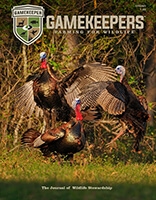The old black-and-white photos hanging on the walls of lodges and hunting camps across North America represent a bygone era—hunters braving the elements in whatever clothing they had in the closet, toting the same shotgun used for all game, and hunting over decoys they likely carved themselves—if they used decoys at all. Though the tools and technology available to today’s waterfowl hunter have evolved dramatically, the fundamental principles that lead to consistent success remain unchanged.
Many variables ultimately dictate how many ducks hang from your strap at the end of the hunt. Some of these are out of your control, like weather or migration timing. But a handful are absolutely within your control, and that’s where a hunter’s focus should lie. Master the controllables, and your odds of success rise significantly.
Find the “X”
In every form of hunting, you must be where the game wants to be. In waterfowl hunting, that precise location is often called “The X”—the exact spot ducks or geese are using. Unless you’re consistently lucky (and few of us are), finding “The X” takes dedicated and intelligent scouting.
Effective scouting hinges on understanding habitat types and how waterfowl use them throughout the season. Duck and goose behavior—particularly where they feed, loaf, and roost—shifts with changes in temperature, wind, food availability, and especially hunting pressure.
For instance, food sources and habitats used during a warm spell will differ from those used during a cold snap. It’s not that ducks completely abandon familiar areas, but how they use those areas—and how aggressively they feed—can change dramatically. Understanding these seasonal shifts helps you narrow your search before you even glass a pond or flyway.
Pressure is another major variable influencing duck behavior. With better gear and improved access to remote spots, more hunters are spending more days in the field—and often in areas ducks previously used for refuge. Increased pressure forces birds to adapt. Human activity—whether it’s shotgun blasts, ATVs, or even birdwatchers—registers as a threat. Ducks typically respond by seeking sanctuary in isolated pockets with dense cover or large, open expanses that allow early visual detection of danger.
Understanding how ducks react to pressure in your area can help you stay one step ahead. Scout smart. Look for overlooked corners, hidden sloughs, or places people can’t or won’t reach. That’s often where pressured ducks end up.
Time of day also plays a role. Ducks might roost in one area, feed somewhere else at dawn, loaf in a different location at mid-day, and return to feed again before sunset. Pinpointing not just where but also when ducks use specific locations is critical. Layer that knowledge with current conditions, and you’ll be a lot closer to consistently finding “The X.”
Scouting doesn’t end once you find the birds. Watch how they behave, how they approach the area, where they’re landing, and how long they stay. Use optics, remain concealed during observation, and take detailed notes. Successful hunts begin long before legal shooting light.
Use the Conditions
You can’t control the weather, but you can use it to your advantage. One of the most critical conditions is wind.
Wind affects duck behavior in several ways, especially how they approach a landing zone. Many hunters instinctively set up with the wind at their backs—because who doesn’t love ducks landing right in their face? But ducks don’t always cooperate, and conditions don’t always favor that setup. Birds tend to approach their destination by flying into the wind. This slows their airspeed, gives them more control, and allows them to study the area below before committing.
One question to always consider: What are the ducks going to see on final approach? The sun, especially, plays a massive role in visibility—for both hunter and bird.
Sunny Days
If the sun is shining and the wind is from the west-northwest, setting up with the wind at your back means you’re staring directly into the morning sun—and so the ducks have the sun behind them. That spotlight effect gives them an advantage, making it easier to spot something suspicious in your spread. In these conditions, a crosswind setup often works better, taking that “stage light” off your group and giving you better shooting angles on crossing birds.
However, if the wind is from the east-southeast on a sunny morning, it’s a different story. Now, the ducks are the ones looking into the sun. This can work to your advantage, allowing for traditional downwind setups with birds landing right into your lap. You can also get away with a little more movement in the blind under these conditions because of the visual limitations for the birds.
Overcast Days
Cloudy skies remove shadows and dramatically improve waterfowl vision. On these days, ducks can detect inconsistencies much more easily. That means poor concealment or awkward blind placement can stick out like a sore thumb.
On overcast days, it’s harder to “hide in the light,” so you must lean even harder into smart setups. Use wind to steer ducks into a crossing pattern. Place your decoys strategically to pull them where you want them. Keep your hide tight. When in doubt, back off the decoys and let the birds finish without staring directly into your face.
Also consider how clouds affect duck behavior. On gray, drizzly days, ducks often fly later into the morning and may feed sporadically throughout the day. Be prepared to hunt longer and adapt on the fly as bird movement shifts.

E. Wall
Hide Like Your Hunt Depends On It (Because It Does)
If there’s one controllable factor that ruins more hunts than any other, it’s concealment. You can be dead-on “The X,” perfectly match your setup to the conditions, and still leave empty-handed if your hide isn’t right.
On the other hand, a well-hidden group in a marginal location with only a few birds around can finish enough ducks to fill the straps—and feed the whole camp.
Regardless of how or where you’re hunting, the goal is the same: eliminate any chance of being seen. That means zero movement, natural blending, and breaking up hard edges.
Flooded Timber
In flooded timber, concealment can be simpler—if you do it right. Stand behind a large tree trunk, stick to the shady side, and stay perfectly still. Canopy cover helps shield you from overhead detection, but things like your proximity to the hole, how much sunlight is filtering through, and where the ducks are entering from all factor in.
Everyone in the group must use their tree correctly and know when not to move. Done right, timber hunts can be magical. But even one fidgeting hunter in the wrong spot can blow the whole show.
Structural Blinds
Blinds—whether A-frames, layouts, or permanent structures—offer comfort, movement concealment, and customization. But the blind itself must be camouflaged properly. It doesn’t matter how hidden you are inside the blind if the structure itself sticks out like a box in a field.
And that’s the key principle: boxes don’t exist in nature. Straight lines, uniform shapes, and manmade materials are red flags to wary birds—especially pressured ones.
Use natural vegetation from the area to blend the blind into its surroundings. Break up edges, add uneven textures, and match colors. Whether you’re using an A-frame on a ditch bank or a layout blind in a cornfield, the same rule applies: the blind should disappear into the environment.
Rotate cover as it browns or breaks down. Add depth with vegetation in front and behind. Make sure shadows and glare are reduced inside the blind by covering anything shiny or light-colored.

B. Martin
Master Your Decoy Strategy
While location, weather, and concealment are foundational, decoy spread design is the next critical piece you can control. Ducks are visual creatures, and the way your decoys are arranged sends a strong message about safety and realism.
Avoid the “blob” effect by spacing your decoys in a natural, uneven pattern. Birds rarely raft up in a perfect circle. Use family groups, open holes, and staggered spacing to simulate natural movement. Leave a well-defined landing zone where you want ducks to finish.
On high-pressure days, less is often more. A small, tight group of decoys in a hidden backwater slough might outdraw a large spread on an open pond. Conversely, when birds are migrating or conditions are windy, a big, noisy spread may pull ducks from a distance.
Add movement with jerk rigs, spinning-wing decoys (when legal and appropriate), or motion ducks. Still water looks unnatural, especially on calm days. But use motion sparingly when birds get spooky—sometimes silence and stillness are more effective.
Change things up when birds don’t finish. Move the landing pocket. Pull the decoys closer to cover. Shift the spinner to a different position—or pull it altogether. Adaptability in decoy strategy often separates a slow hunt from a good one.

Rob Kinney
Final Thoughts: Control the Controllables
There are countless methods, theories, and gadgets out there claiming to boost your waterfowl success. But the truth is, too many environmental and biological factors are beyond your control to guarantee anything. What you can control is your own effort and execution.
Scout smart. Know where the birds are and how they’re using the area. Use the conditions. Adjust your setup based on wind, sun, and sky. Conceal yourself. Eliminate straight lines and movement—make your setup disappear. Build a smart spread. Use decoys to tell the right story and adapt as needed.
Master these fundamentals, and your success will reflect your effort. Waterfowl hunting isn’t about stacking limits every day—it’s about matching wits with wild birds in wild places. But when you do your part right, you’ll find that sometimes, the ducks do too.
-
Join our weekly newsletter or subscribe to Gamekeepers Magazine.
Your source for information, equipment, know-how, deals and discounts to help you get the most from every hard-earned moment in the field.









